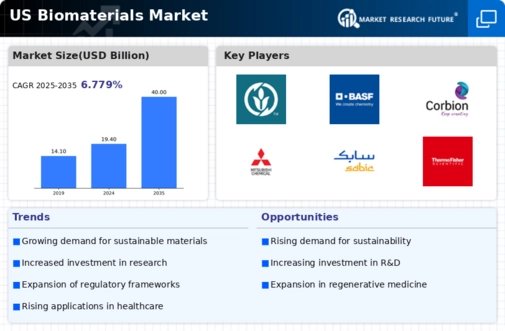Emphasis on Patient-Centric Care
The shift towards patient-centric care in the healthcare sector is significantly influencing the biomaterial wound-dressing market. Healthcare providers are increasingly focusing on personalized treatment plans that cater to individual patient needs, which includes the use of advanced biomaterials for wound management. This approach not only enhances patient satisfaction but also improves healing outcomes. As a result, the biomaterial wound-dressing market is likely to witness a rise in demand for customized solutions that align with this trend. The emphasis on patient-centric care is expected to drive innovation and development in the biomaterial sector, further expanding the market.
Rising Prevalence of Diabetic Foot Ulcers
The rising prevalence of diabetic foot ulcers in the United States is a critical driver for the biomaterial wound-dressing market. With an estimated 29 million individuals diagnosed with diabetes, the incidence of foot ulcers is alarmingly high, affecting nearly 15% of diabetic patients. This condition necessitates effective wound management solutions, thereby propelling the demand for biomaterial dressings that facilitate healing and minimize complications. The biomaterial wound-dressing market is expected to benefit from this trend, as healthcare providers seek to implement advanced materials that can enhance patient outcomes and reduce healthcare costs associated with prolonged treatment.
Technological Innovations in Biomaterials
Technological innovations in biomaterials are a pivotal driver for the biomaterial wound-dressing market. Recent advancements in material science have led to the development of novel biomaterials that exhibit superior properties, such as enhanced biocompatibility and controlled drug release. These innovations are likely to improve the efficacy of wound dressings, making them more appealing to healthcare providers. The biomaterial wound-dressing market is projected to benefit from these advancements, as they enable the creation of products that not only promote healing but also reduce the risk of infection. As research continues to evolve, the market is expected to expand, driven by the introduction of cutting-edge biomaterial solutions.
Growing Investment in Healthcare Infrastructure
The biomaterial wound-dressing market is poised for growth due to increasing investments in healthcare infrastructure across the United States. Government initiatives aimed at improving healthcare access and quality are likely to enhance the availability of advanced wound care products. For instance, the U.S. government allocated approximately $1.5 trillion to healthcare in 2025, which includes funding for innovative medical technologies. This financial support is expected to facilitate the adoption of biomaterial dressings in hospitals and clinics, thereby driving market growth. As healthcare facilities upgrade their wound care protocols, the biomaterial wound-dressing market is likely to see a corresponding increase in demand.
Increasing Demand for Advanced Wound Care Solutions
The biomaterial wound-dressing market is experiencing a notable surge in demand for advanced wound care solutions. This trend is driven by the growing awareness among healthcare professionals and patients regarding the benefits of biomaterials in promoting faster healing and reducing infection rates. The market is projected to reach approximately $3 billion by 2026, reflecting a compound annual growth rate (CAGR) of around 8% from 2021 to 2026. As healthcare providers increasingly adopt these innovative solutions, the biomaterial wound-dressing market is likely to expand significantly, catering to a diverse range of applications, including surgical wounds, burns, and chronic ulcers.




















Leave a Comment